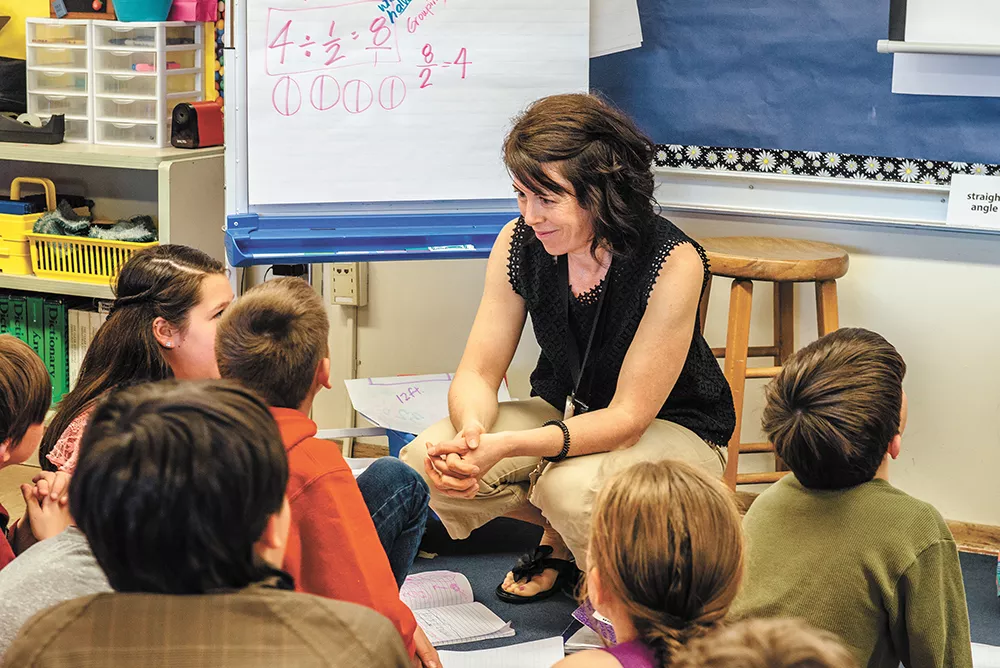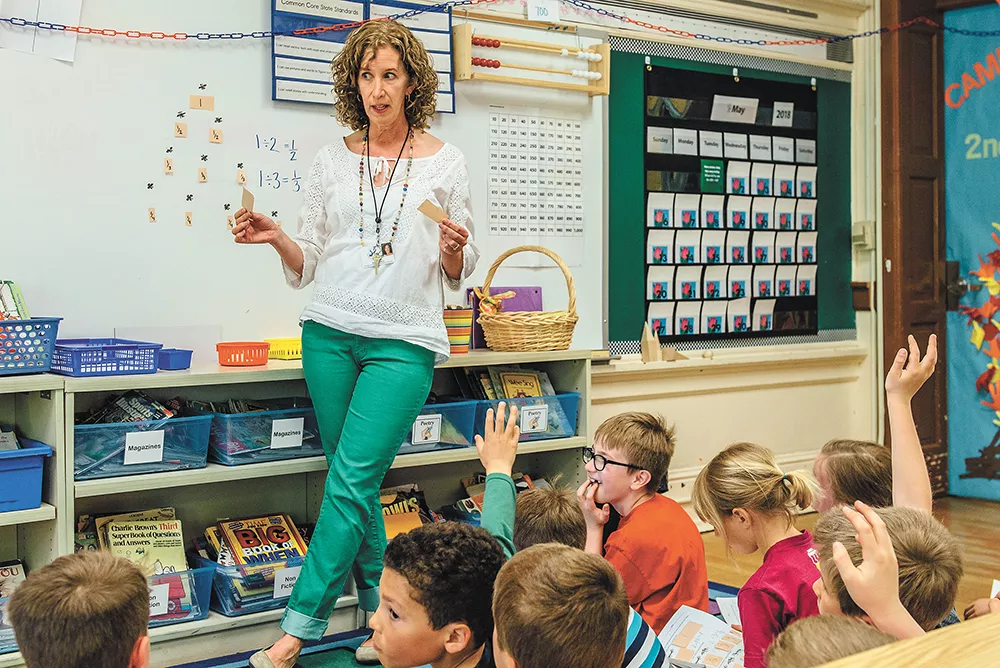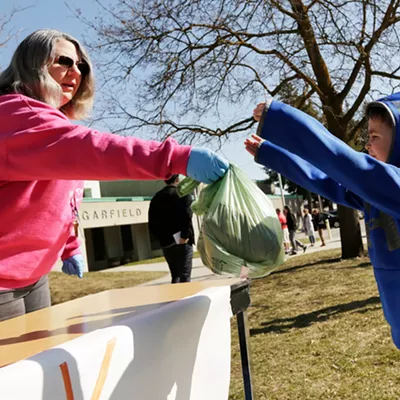
In teacher Beth O'Regan's Franklin Elementary classroom, learning how to multiply and divide fractions isn't as simple as memorizing the answer to the equation.
Rather, O'Regan asks her kids to understand the question.
"Good mathematicians really understand the heart of the work," O'Regan tells her students, who all sit together on the floor under a projection screen.
The problem, in this case, is one-half divided by four. Some think it might be eight. Many of the fourth and fifth-graders think it's one-eighth (which is correct).
O'Regan doesn't tell them either way. Instead, the students turn to the person sitting next to them and discuss a word problem representing the equation. Eventually, the class lands on one: You have half of a pie, and you split it into four. How much pie will each person get?
It's an example of the new way kids will learn math in Spokane Public Schools. From kindergarten until 10th grade, the district is rolling out new math curriculum aligned with Common Core standards, representing a major shift in how Spokane students will learn math.
Instead of teachers showing kids how to solve a problem, kids will be encouraged to use their own thinking. Instead of memorizing formulas, students will strive to understand them.
"The curriculum we were using was, 'I'm going to show you how to do it and you're going to practice it," O'Regan says. "Now, it's: 'Let's teach them to have conversations that will allow them to make sense of something.'"
It's Spokane's latest move in the so-called "math wars" facing educators across the country. As math scores stagnate nationally, schools' attempts to reform math with conceptual, exploratory teaching has been met with opposition from parents, who were taught typically to memorize the skills and formulas to solve problems.
With this new curriculum, Spokane hopes it can do both.
Across the courtyard from O'Regan's classroom at Franklin, Ellen Nessen's second-graders imagine ants eating granola bars. There's one granola bar and three ants, Nessen tells the class. Each ant gets an equal part of the granola bar. What do you call those parts?
The second-graders knowingly gasp, shooting their arms into the air in anticipation.
"Thirds," one student says.

The exercise continues for fourths and other fractions. It's a representation of the Common Core standard that the second-graders understand that a fraction is dividing a whole into equal parts. The Bridges in Mathematics curriculum adopted by Spokane Public Schools follows that standard.
For Nessen, it's important that the students understand what fractions are before doing procedures.
"It's that issue of helping them make meaning from a model," Nessen says. "Having context, instead of just being taught to memorize procedures."
The Bridges in Mathematics curriculum was implemented for kindergarten through second grade this school year in Spokane Public Schools. Next year, the new curriculum will hit grades three through five, with different curricula simultaneously going into grades six through 10. O'Regan's class served as the pilot for the new curriculum in fifth grade this year.
With all of it, the district hopes to strike a balance in the contentious debate between skills-based learning and conceptual understanding of mathematics.
"Our hope is to have a program that's both," says Matthew Henshaw, director of elementary curriculum for Spokane Public Schools. "We want something that helps support skills, and also is comprehensive in helping students understand the math itself and the conceptual understanding, so they can retain the knowledge."
For example, the learning about fractions doesn't stop once students understand that dividing a whole into three equal parts represents thirds. The students are then asked to put that knowledge into practice. They're tasked with solving a series of problems on fractions using their new understanding.
That was the biggest problem with the curriculum used from the late 1990s until a few years ago, Henshaw says. It taught students in a more conceptual way, but it lacked the skills-based practice.
Then, a few years ago the district switched to a different curriculum to follow Common Core standards. But there were problems with that too: It had teachers directing students how to do math, instead of guiding students to a better understanding, says Kim Newton, a teacher at Grant Elementary who was part of the district's curriculum adoption committee.
Teaching only skills creates gaps among a classroom, Newton says. Under the traditional method, students naturally good at memorization are naturally better at math, while students who struggle with memorization feel like they'll never be as good at math. It doesn't have to be that way, Newton says.
"You're not born with or without a math brain," Newton says.
It's about changing the way kids think about math, says Tricia Gessele, coordinator for elementary math in Spokane Public Schools.
"It's very common to hear people say, 'I'm not a math person.' But you never hear someone say, 'I'm not a reading person.'" Gessele says. "One of our big goals is to shift that culture."
Think back to the 1960s, 1970s and 1980s — when parents nowadays were in school learning math. The demand for jobs requiring proficiency in science, technology, engineering and math (STEM) was nowhere close to the demand for those jobs now.
"We need more of those students to take those jobs on," Henshaw says.
And colleges don't just want people who can calculate equations in their head — calculators can do that, too.
"They want thinkers," Henshaw says. "If I'm an engineer or computer scientist, I have to problem solve and have that full package."
Jackie Coomes, a math professor at Eastern Washington University, agrees. She points out that the goal of Common Core was to make students more college ready. She says it's important that students can think through a problem by themselves or with a team; that they become "interdependent and independent learners."
"That's more important than what they have memorized," Coomes says.
Coomes says she wants her students to be fluent with the facts. They should know basic formulas and equations. But they should also have strategies to figure out the answer if they don't know right away.
Coomes recently led a three-year project training teachers and aspiring teachers on Common Core. The goal, she says, was to improve the teaching of math so it's "more coherent." It's gotten results: The students who were taught by those Spokane-area teachers achieved higher marks than other students in the state.
Finding a middle ground in the math wars is critical, she says. Teachers shouldn't always refuse to tell students the answer to a problem, she says. They need to use their best judgment on when that's appropriate.
"That's why teachers need really good instructional strategies," she says. "Most students really like math more when it makes sense."
Still, some students are bound to struggle more than others. Spokane schools have been training teachers to recognize that in their students. Since 2012, the district conducted a program to train teachers to become "Math Recovery Intervention Specialists" and learn how to intervene when a student is struggling in math.
Years later, however, the schools that implemented the program did not show gains in math scores compared to other schools.
It's an example of the difficulty in teaching math. The Math Recovery program was research-based, Gessele says. Teachers who have been trained in Math Recovery have loved it. But it hasn't been proven to work for kids in Spokane.
"I don't think we can say any one thing is making or breaking the system," Gessele says.
Coomes says there's a common "implementation dip" when new curriculum arrives in schools. It takes a few years for students to see results. Teachers need time to learn it, too.
For teachers O'Regan and Nessen, however, the proof the curriculum works can be found in the classroom, where all of the students are actively engaging with the lesson. Every kid feels like they can do math, and they work together to solve a problem, to ask the right question.
"If they don't know how to question or clarify," O'Regan says, "then kids won't move forward."♦




















